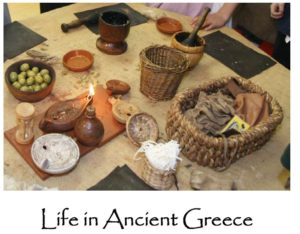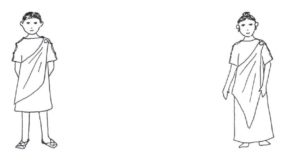Greek Workshop
Dear all,
Here are some inspirations for our Greek Workshop (in courtesy of www.historyoffthepage.co.uk). It would be awesome, if everybody could dress up in Greek style.
Introduction
On this day your child, will through role-play, experience life as it would have been living in the year 490 BC at the time of the Battle of Marathon, using authentic tools and materials whenever possible to learn skills as apprentices in a wide variety of workshops. As the day progresses, the children will get involved in the issues of the time, with the chance to participate in a range of cross-curricular activities. By the end of the day they will have a really good idea of how it felt like to be a Greek citizen at this pivotal date in history, which led to the rise of Athens as a major power in the ancient world.
There will also be a story-telling session.
A simple costume will help your child really feel part of the day.
Choose your own name for the day:
Boys names include: Aigeus, Aristeides, Amphitrion, Aristoteles, Diomedes, Heracles, Idomeneus, Iktinos, Iphicles, Kallicrates, Meleagros, Pericles, Perseus, Protagoras, Themistocles, Theseus
Girls names include: Alkmene, Artemis, Alkestes, Aithra, Ariadne, Antioppe, Chryseis, Danae, Electra, Elpinike, Hermione, Hippolyte, Iokaste, Kassiope, Nephele, Praksithea, Thetis,
There will be 10 different workstations that children will participate at.
Setting:
The year is 490 BC, and near Athens the battle of Marathon rages on. The pupils will take the roles of Athenian citizens at the time of the battle of Marathon. From the safety of the Agora, the pupils await news of the outcome of the battle, discussing the events that led to this pivotal date in Greek history, and to the rise of Athens as a major power in the ancient world.
Greek Costume:
It would help the pupils engage with the period and role-play if they wore simple costumes. Most Athenians wore clothes made from finely spun wool or linen of various textures. Rich people wore colourful clothes and fine jewellery. Poorer Athenians wore rough, undyed wool. Braid was often used for decoration or as a formal border
Simplest costume: A large plain T-shirt with a belt or cord tie.
A simple tunic (Chiton for girls) is made from a single rectangle of material, the length of the child from neck to knee or calf (plus turnings) by about twice the width of the child from wrist to wrist. Fold in two width ways and stitch the seam. Hem top and bottom. Mark a gap for the head at the centre of the top edge. From the head gap, mark points at 10 centimetre intervals to the end of the fabric. At each point sew a button through both layers. Cut a length of cord for the waist. To wear, the pupil puts his/her head through the centre hole and each arm through the final shoulder gaps. Tie cord around waist.
You may wish to add a Himation, a rectangle of coloured cloth fastened with a brooch or button on the left shoulder.
Pretending to be a particular character from history or mythology is inappropriate and does not help the day in any way.
If you are still unsure, “Professor Google” always has an answer and idea.


